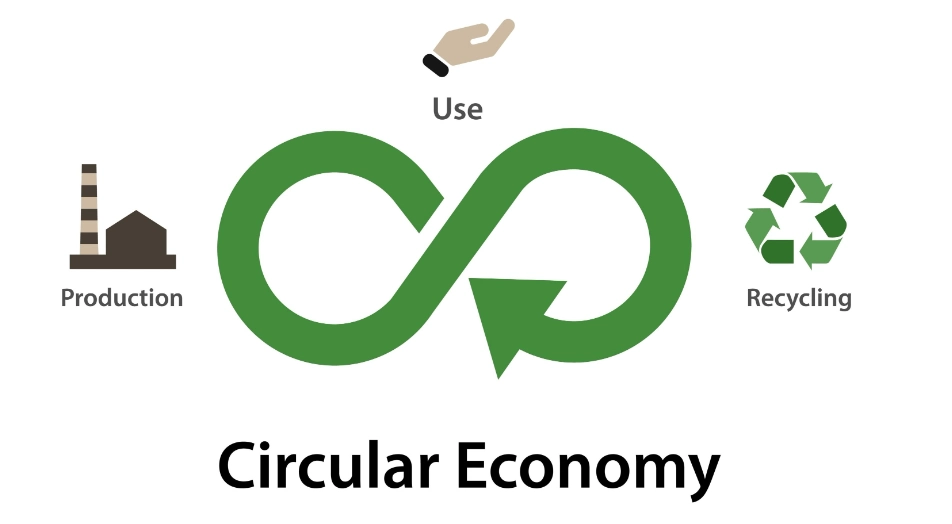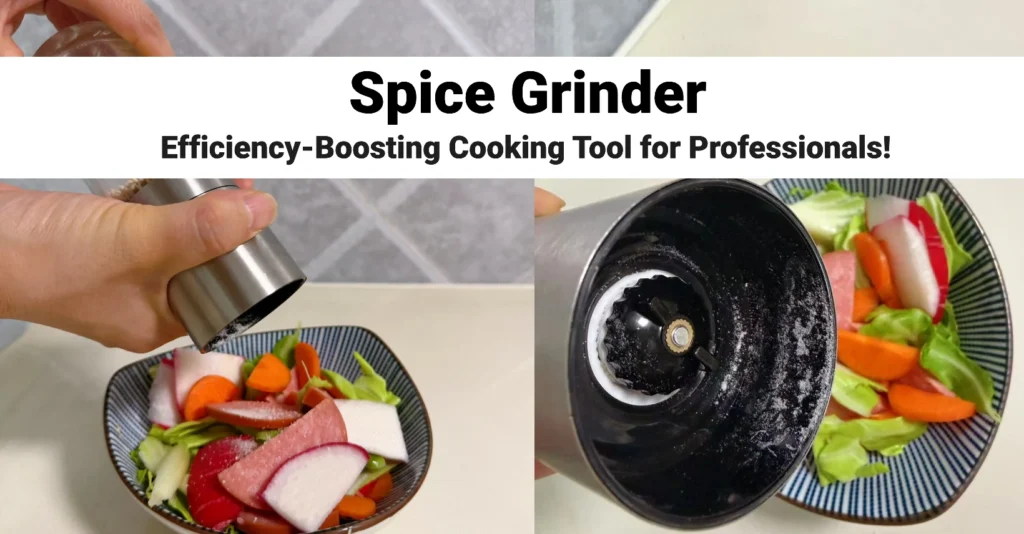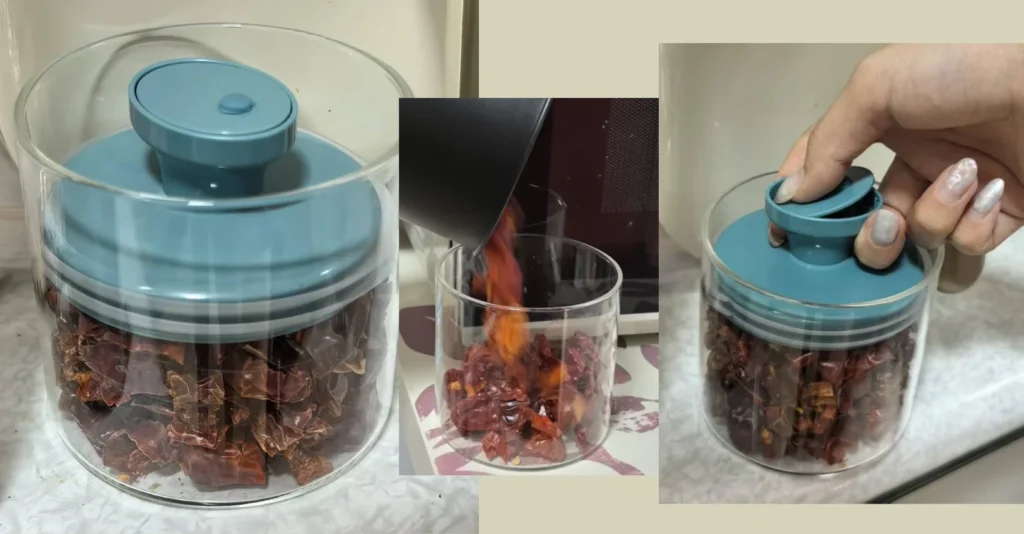For many coffee aficionados, the French press is the key to a truly exceptional cup of coffee. Its unique brewing method delivers a rich, full-bodied flavour profile that is hard to replicate. If you’re looking to elevate your home coffee experience, learning how to make French press coffee is a rewarding journey. This guide will walk you through everything you need to know, from understanding what French press coffee is to mastering the art of the perfect brew and even finding the right equipment.

What is French Press Coffee?
French press coffee, also known as press pot or plunger pot coffee, is a brewing method that involves steeping coffee grounds in hot water and then separating the grounds from the brewed coffee using a mesh plunger. Unlike drip coffee makers that use paper filters, the French press utilizes a metal filter. This allows the coffee’s natural oils and fine sediments to pass into the final cup, resulting in a brew that is typically richer, more robust, and has a more pronounced mouthfeel.
How Does the French Press Coffee Work?
The magic of the French press lies in its simplicity and the immersion brewing process. Here’s a breakdown:
- Immersion: Coarsely ground coffee beans are placed in the beaker. Hot water is then poured over the grounds, allowing them to steep and fully immerse. This direct contact between water and coffee grounds enables a thorough extraction of flavour compounds, oils, and aromatics.
- Steeping: During the steeping time (typically a few minutes), the coffee grounds release their soluble components into the water. This is where the depth of flavour is developed.
- Filtration: Once steeping is complete, a plunger with a fine mesh filter is slowly pressed down. This action separates the brewed coffee from the grounds, pushing the grounds to the bottom of the beaker and leaving the ready-to-drink coffee above the filter.
This method offers a more direct infusion compared to other brewing techniques, leading to its characteristic bold and flavourful output.
Step-by-Step: How to Make French Press Coffee
Ready to brew? Here’s your simple guide to French press perfection:
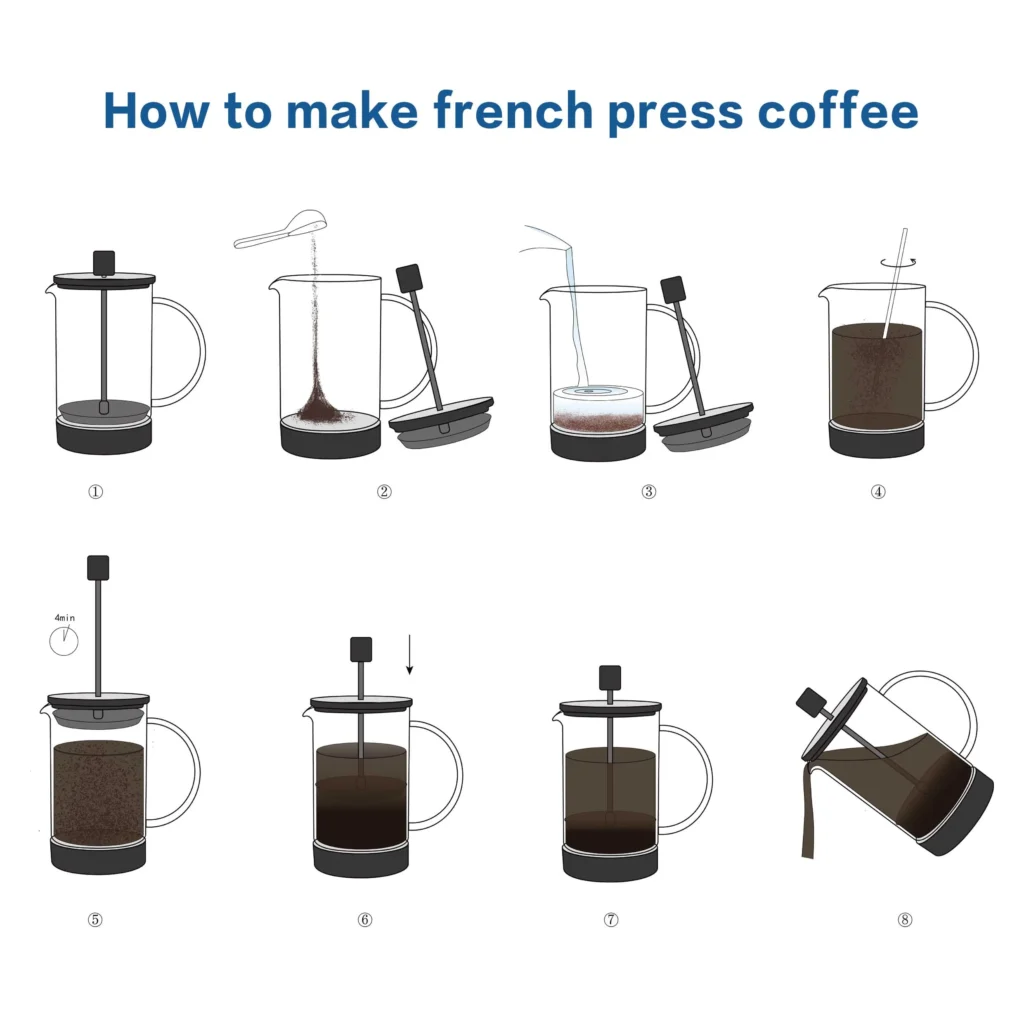
Step 1: Heat Your Water
Start by heating fresh, filtered water to the optimal temperature. We’ll discuss the ideal temperature in more detail later, but aim for just off the boil.
Step 2: Grind Your Beans
This is a crucial step. For the french press, you need a coarse grind, similar in consistency to breadcrumbs or sea salt. If your grind is too fine, you’ll end up with a muddy, over-extracted brew and sediment in your cup.
Step 3: Add Coffee Grounds to the Press
Remove the lid and plunger from your French press. Add your coarsely ground coffee to the bottom of the empty beaker. A common starting ratio is 1:15 (coffee to water), but we’ll delve into ratios further down.
Step 4: “Bloom” the Coffee (Optional but Recommended)
Once your water is at the right temperature, pour just enough to saturate all the grounds. You’ll see the coffee “bloom” – it will puff up and release gases. Let it sit for about 30 seconds. This step enhances the flavour.
Step 5: Pour the Remaining Water
After the bloom, pour the remaining hot water into the press, ensuring all grounds are submerged.
Step 6: Steep
Place the lid on top of the French press with the plunger pulled all the way up. Do not press down yet. Let the coffee steep for the desired amount of time, typically 4 minutes.
Step 7: Press the Plunger
Once steeping is complete, it’s time to press. Slowly and steadily push the plunger down with even pressure. Pressing too quickly can agitate the grounds and lead to a bitter taste.
Step 8: Serve Immediately
Once the plunger is fully pressed, pour the coffee into your mug(s) right away. Leaving the coffee in the press after plunging can lead to over-extraction and a bitter taste.
Step 9: Clean Your Press
Don’t forget to clean your French press promptly after use to prevent coffee oils from building up and affecting future brews.
Tips For Making French Press Coffee
Use Freshly Roasted Beans: The quality of your beans makes a huge difference. Opt for freshly roasted, high-quality coffee.
Grind Just Before Brewing: Coffee loses its aroma and flavour quickly after grinding. Grinding your beans right before you brew will significantly improve the taste.
Preheat Your Press: Rinsing your empty French press with hot water before adding the grounds helps maintain a consistent brewing temperature. Simply add hot water, swirl it around, and then pour it out.
Use Filtered Water: Coffee is mostly water, so the quality of your water will impact the taste. Filtered water is recommended.
Don’t Underestimate the Bloom: That initial 30-second bloom can make a noticeable difference in flavour.
Pour Gently: When pouring the hot water, do so gently to avoid agitating the grounds too much.
Adjust to Your Taste: The beauty of French press is its customisability. Experiment with grind size, coffee-to-water ratio, and steep time to find your perfect cup.
Avoid Over-Extraction: As mentioned, pour the coffee immediately after pressing to prevent bitterness.
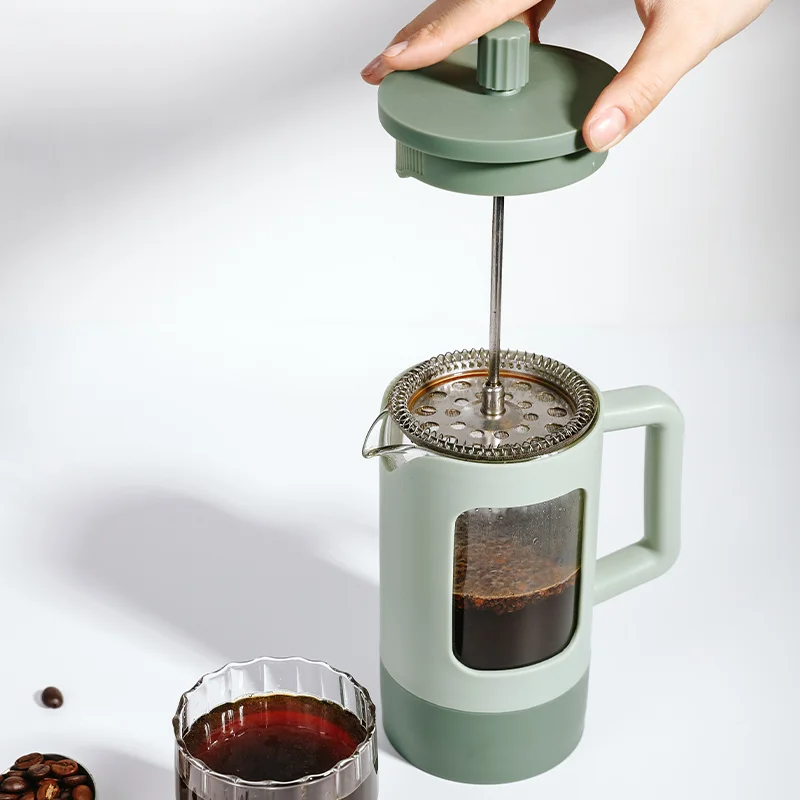
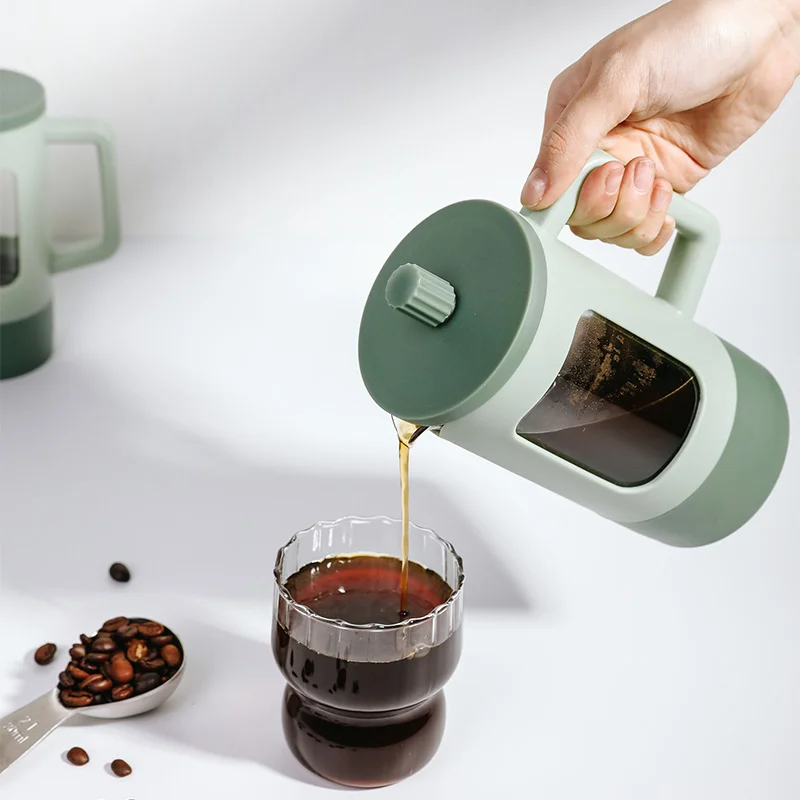
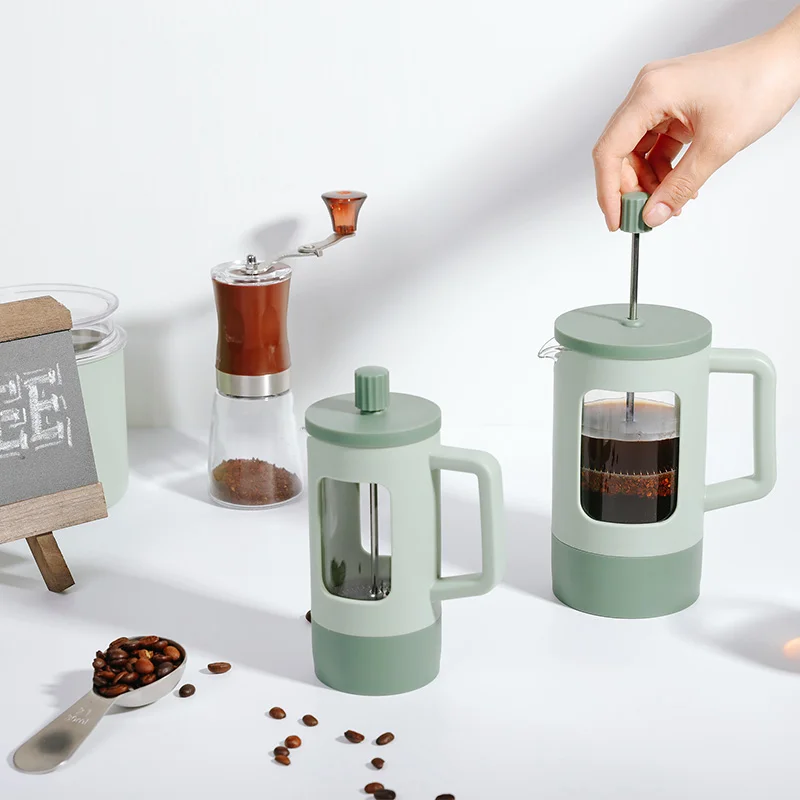
Ratio of Water & Coffee for the French Press
The ideal coffee-to-water ratio for the french press is subjective and depends on your preferred strength. However, a widely accepted starting point and often referred to as the “golden ratio” is 1:15. This means for every 1 gram of coffee, you use 15 grams (or 15 ml) of water.
Here’s a quick reference:
- For a stronger brew: Try a ratio of 1:12 or 1:13.
- For a milder brew: Try a ratio of 1:16 or 1:17.
It’s highly recommended to use a kitchen scale to measure your coffee and water for consistency. If you don’t have a scale, a general guideline is about 2 tablespoons of coarse coffee grounds per 6 ounces (177 ml) of water. Remember to adjust based on your taste preferences.
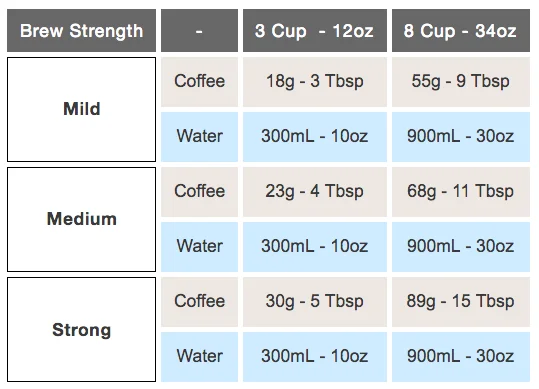
Pros and Cons of Making French Press Coffee
Pros:
- Rich, Full-Bodied Flavour: The metal filter allows natural oils and fine particles into the cup, creating a robust and flavourful brew.
- Control Over Brewing Variables: You have direct control over grind size, water temperature, coffee-to-water ratio, and steep time, allowing for a highly customised cup.
- Relatively Inexpensive Equipment: French presses are generally affordable compared to some other coffee brewing methods.
- No Paper Filters Needed: This means less waste and no paper taste interfering with your coffee’s flavour.
- Versatile: Can be used to make cold brew coffee as well.
Cons:
- Sediment in the Cup: Some fine sediment is characteristic of French press coffee, which not everyone enjoys.
- Potential for Over-Extraction: If not poured immediately after pressing, the coffee can continue to extract and become bitter.
- More Manual Process: Requires more attention and effort compared to automatic drip machines.
- Cleaning Can Be Tedious: Cleaning out the coffee grounds can be a bit messy.
- Grind Consistency is Key: Requires a consistently coarse grind for best results; an inconsistent grind can lead to a poor-tasting brew.
Why We Recommend the EasyLife Best French Press
Not all French presses are created equal. We designed the EasyLife French Press with the perfect cup in mind. Here’s why it stands out:
- Superior 4-Level Filtration: Say goodbye to grit! Our innovative, ultra-fine stainless steel mesh filter system ensures a smooth, clean cup every time, trapping even the finest grounds.
- Heat-Resistant Borosilicate Glass: The durable glass carafe can handle rapid temperature changes without cracking, and its clarity lets you watch the beautiful brewing process unfold.
- Comfort and Control: The non-slip, soft-grip handle makes for a comfortable and secure pour, giving you confidence and control from kitchen to cup.
- Easy to Clean: The entire filter assembly easily screws apart, and the glass carafe is dishwasher safe, making cleanup a breeze.
- Different sizes for you to choose from: EasyLife has various sizes of the glass french press, such as the large french coffee press, which can meet your needs in different scenarios.
With the EasyLife Best French Press, you’re not just buying a coffee maker; you’re investing in a consistently better coffee experience.
FAQ: Your French Press Questions Answered
How much coffee in French press?
As mentioned in the ratio section, a common starting point is a 1:15 coffee-to-water ratio. For example, for a 350 ml (approximately 12 oz) French press, you would use about 23 grams of coffee. For a larger 1-liter (approximately 34 oz) press, you’d use around 67 grams of coffee. Adjust this based on your strength preference. Using a scale is the most accurate way to measure.
How long to steep coffee in French press?
The general recommendation for steeping time is 4 minutes. However, this can be adjusted based on your grind size and taste preference.
* If your coffee tastes weak or sour, try a slightly longer steep time (e.g., 4.5 to 5 minutes).
* If it tastes too bitter or strong, you might be over-extracting, so try a shorter steep time (e.g., 3 to 3.5 minutes). Don’t forget to include the 30-second bloom time within your total steep duration if you choose to bloom your coffee.
Water temp for French press coffee?
The ideal water temperature for French press coffee is typically between 90°C and 96°C (195°F and 205°F). This is just off the boil. If your kettle doesn’t have a temperature setting, bring the water to a boil and then let it sit for about 30 seconds to 1 minute before pouring. Water that is too hot can scorch the coffee grounds, leading to a bitter taste, while water that isn’t hot enough will result in under-extraction and a weak, sour cup.
Do you stir French press?
Yes, a gentle stir can be beneficial. After pouring the initial water (especially during the bloom or just after adding all the water), a gentle stir helps ensure all the coffee grounds are saturated and encourages even extraction. Avoid vigorous stirring, as this can lead to over-extraction and a muddy cup. Some methods also suggest gently breaking the “crust” of coffee grounds that forms on top before pressing.
Is a French press better than drip?
“Better” is subjective and depends on individual preferences.
* French press typically produces a richer, more full-bodied coffee with more oils and sediment due to the metal filter and immersion brewing. It offers more control over the brewing process.
* Drip coffee (especially with paper filters) tends to be cleaner, with a lighter body, as the paper filter absorbs oils and removes fine particles. Automatic drip machines offer more convenience.
If you prefer a bold, textured cup and enjoy the hands-on process, French press might be better for you. If you prefer a cleaner cup and convenience, drip might be your go-to.
Can you use regular ground coffee in a French press?
It’s not recommended to use regular pre-ground coffee (often ground for drip machines) in a French press. This type of coffee is typically ground too finely. A fine grind in a French press can:
*Pass through the mesh filter, resulting in a silty, gritty cup.
*Lead to over-extraction, making the coffee taste bitter.
*Make it difficult to press the plunger down.
For the best results, always use a coarse grind specifically for French press.
Do I Need To Buy a Grinder To Make French Press Coffee?
While you can buy pre-ground coarse coffee, investing in a quality burr grinder is highly recommended for the best French press experience. Here’s why:
* Freshness: Coffee beans start to lose their flavour and aroma rapidly after being ground. Grinding fresh before each brew makes a significant difference in taste.
* Grind Size Consistency: Burr grinders (as opposed to blade grinders) produce a much more consistent coarse grind, which is crucial for even extraction and a balanced French press brew. Blade grinders produce inconsistent particle sizes, leading to both under and over-extraction.
* Control: Owning a grinder gives you full control over the coarseness, allowing you to dial in the perfect grind for your specific French press and preferences.
While it’s an added expense, a good burr grinder is often considered the most important piece of equipment for anyone serious about brewing delicious coffee at home, regardless of the method.
Conclusion: Your Journey to French Press Perfection with EasyLife Starts Now
Mastering the French press is a rewarding endeavour that unlocks a world of rich, full-bodied coffee flavours right in your kitchen. From understanding the importance of a coarse grind to perfecting your steeping time and coffee-to-water ratio, you now know how to make french press coffee. While there might be a slight learning curve, the ability to control every aspect of the brewing process allows for a truly personalized and superior coffee experience. Remember, the best cup of French press coffee is the one that tastes perfect to you.
Ready to elevate your coffee game and experience the difference quality equipment makes? Explore EasyLife’s premium selection of French press coffee makers today and start your journey to the perfect brew! Discover why our customers trust EasyLife for their daily dose of delicious, effortlessly brewed coffee.

